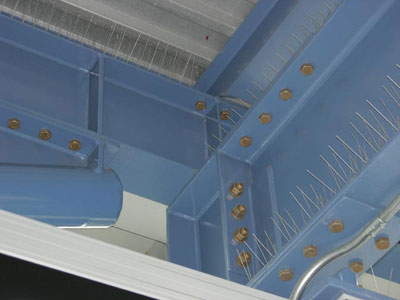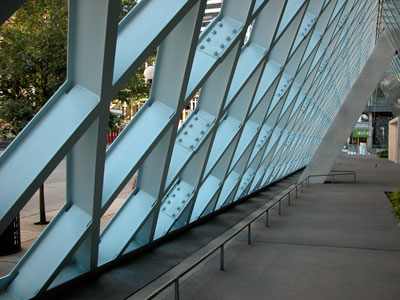Finishes
The Impact of Finish Choice on Connection Design
THINKING ABOUT COATINGS & FINISHES - GENERAL ISSUES
It was intentionally the design of the Matrix and AESS Specifications to exclude coatings as a parameter or characteristic. The issue of Coatings and Finishes is a highly complex area of concern and one that may override the decision making process regardless of the AESS Category.
ARCHITECTURALLY EXPOSED STRUCTURAL STEEL: PART TWO
Coatings & Protection
Sponsored by the American Collegiate Schools of Architecture (ACSA)
The selection of the coatings and finishes for AESS work needs to be known at the outset of the project. The nature of the finish will in many cases begin to dictate the level of surface preparation required for the various elements of the structure as well as much of the fabrication detailing. The properties of different coatings can even begin to skew the decision making process outlined within each of the distinct categories of the Matrix.
Generally speaking coatings can be divided into two general categories:
- those that reveal or exacerbate the surface conditions and potential imperfections in the steel (thin coat or glossy finishes), and
- those that will conceal such surface conditions, and potentially hide aspects of intended details (thick coats and matte or mottled finishes).
 |
 |
Extreme care and highly specialized detailing was required to join the branches of this tree to the casting nodes of this AESS4 structure. Mechanical pipe was selected for its seamless appearance and structural properties. |
The surface had to be perfect given the application of a glossy painted finish and focus lighting. This required extra expense for filling and grinding of all welds. |
Coatings will also be influenced by interior or exterior locations. This will include issues of weathering, exposure to ice, snow and rain, as well as atmosheric pollution. Details will have to be designed to drain, shed water, and coatings chosen that will prevent corrosion on both the exterior and interior of members. If similar members are being used on the interior and exterior of the project, consideration must be given to a coating selection that will work with the details in both places.
The selection of the finish may be governed by fire protection concerns rather than aesthetics. This would be the case with the choice to use intumescent coatings over a regular painted finish. Where some intumescent coatings are fairly thin and will allow details to show through, others are by their nature quite thick. Spending project dollars on highly complex articulated details makes little sense if these are to be coated with a heavy material. Conversely, if an extremely glossy finish is desired, this might lead to design decisions that preference welded conditions over bolted ones given the inference of clean lines.
Welded versus Bolted Structures. Different coatings, finishes and types of texture of the coatings and finishes may be more or less appropriate as a function of the tectonic expression of the structure. Much of the tectonic character will be defined simply by the choice to use welded or bolted connections as the main method of attachment for the structure.
Shop versus Site Painting. It may be much more expedient and desirable to pre-finish AESS structures in the fabrication shop. Controlled conditions can lead to a better final product. This is even more the case if the geometries are highly complex or if there will be accessibility issues in painting the structure on site. There are situations where the erection of scaffolding is prohibitively expensive or strategically impossible. If it is the intention to pre-finish members, then extra care will be required to transport the elements to the site as well as during the erection process. Even with extraordinary care, touch ups can be expected.
CLEANING AND MAINTENANCE
AESS installations might never look as good as the day on which the building was opened. Seldom considered in many projects are issues related to the maintenance and cleaning of the structures. White is a fashionable colour for AESS, yet where it is installed in areas of high urban pollution, can age quickly. Certain steel shapes can be more easily cleaned by high pressure washing than others.
 |
 |
The white painted finish on this exposed steel exterior stair was not a good choice. Salt applied to the treads has resulted in rust stains on both the supporting steel and the concrete below. A paint finish of any colour is really not suitable for areas of high exterior exposure, particularly where also subjected to de-icing agents. |
The painted white structure at the TGV Station at the Charles de Gaulle Airport in Paris has proven difficult to keep clean. Access is not possible over the full width of the station, leading to severe build up of grime over part of the structure. The structure is easily viewed from above, making the condition of the surface even more obvious. |
Flat surfaces and ledges can provide areas to collect debris. Both the details and the durability of the coatings need to address the urban menace presented by pigeons. Their droppings are corrosive as well as a nuisance.
 |
 |
The many ledges in this project design have allowed for pigeons to freely roost. Their droppings are a nuisance and also tend to be corrosive to some products. |
Special pigeon deterring products are available that can be used to prevent roosting. Some are not very obtrusive. As can be seen in this detail, the choice to use wide flange sections has provided ledges for roosting. |
SURFACE PREPARATION
Surface preparation will be done in accordance with the chosen AESS category (1 through 4 or Custom). Where there are different AESS Categories used in the project, there may also be different surface preparations and different finishes required. It is essential in AESS applications that proper surface preparation takes place. If the surface is not adequately cleaned prior to the application of the coating system, the coating system may fail or the surface deficiencies will show through.
 |
 |
This AESS structure has been sandblasted prior to painting to arrive at this uniform textured surface. The treatment helps to conceal potential fabrication inconsistencies in this high profile structure. |
It can be seen that the interior of the column is also sandblasted and nicely finished. As you can see to the interior as a result of the lozenge shaped cutouts, it is justifiable that some expense and attention be paid to finishing the interior of the column. |
Finishes for exterior steel structures will need to pay special attention to the prevention of corrosion. Paint will not make up for design deficiencies. Even the most sophisticated epoxy and vinyl paint coatings cannot compensate for details that create opportunities for corrosion to occur. The basic selection of member type and connection detailing for exterior structures should ensure that there are no places where water and debris can collect or puddle. With some care and attention orientation problems can be overcome. Beams and channels should be orientated with the webs vertical so that water cannot collect and stand for any period of time. Exposed steel on which moisture can collect should be detailed with a slope to ensure drainage. Drain holes can be added if you know the section cannot be oriented or sloped to drain.
 |
 |
This AESS structure is located in an airport parking structure in a dusty desert environment. The top of the HSS tubes is covered with grime and there is evidence of the dirt dripping to the underside of the tubes. Even though the circular shape of the member does not provide flat ledges as would a wide flange shape, the choice of colour does not assist in keeping the structure clean in appearance. |
The exterior diagrid screen on the Seattle Public Library by Rem Koolhaas has small cutouts where the wide flange sections have been welded together. This is in part to relieve stress at the location and in part to permit drainage and limit accumulation of water at the bottom of the diamonds. It can also be seen that this structure combines welded and bolted connections in a rather discreet way. |
When using hollow sections or composite members that create voids on exterior applications it is also necessary to prevent corrosion to the interior surfaces. Often "seal welds" are specified to prevent the entrance of moisture or oxygen-laiden air into the cavity. For architecturally exposed steel that is to be painted, seal welds may be specified to prevent unsightly rust bleeding.
Seal welds may be specified on parts to be galvanized to prohibit pickling acids and/or liquid zinc from entering into a specific region during the galvanization process however you NEVER galvanize a closed volume as it will cause an explosion. You always want aired access for the molten zinc to reach all surfaces and therefore avoid explosions. For HSS you are often better off to instead simply provide drainage at the bottom of the element to ensure that gasses do not get trapped. Proper communication is important when deciding on the method of prevention of moisture entry on sealed joints. Seal welds can alter load paths and are prohibited in some structural situations. It might be better to provide a vent space and also galvanize the interior of hollow sections. This will increase costs but will potentially provide a more durable exterior coating.
